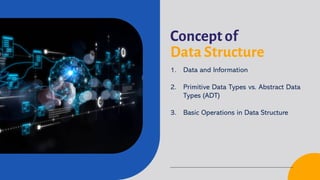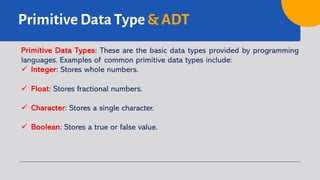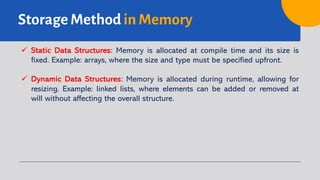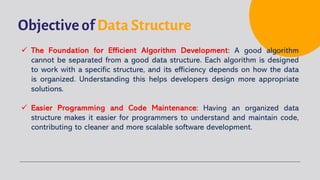Data Structure - 2 Introduction of Data Structure
- 1. Department of Informatics Faculty of Industrial Engineering Universitas Pembangunan Nasional “Veteran” Yogyakarta Data Structure Andi Nurkholis, S.Kom., M.Kom. Introduction of Data Structure August 25, 2025
- 2. Importance of Data Structure We live in a digital era that generates big data from various activities, such as online shopping, social media, research, and IoT. Global data volumes are increasing rapidly every year, taking various forms such as text, images, audio, video, and structured and unstructured data. The main challenge is not only storing this data, but also managing it efficiently, quickly, and in an organized manner so that it can be utilized for decision-making, analysis, and system operations.
- 3. Definition of Data Structure Data structure is a specialized representation of data that allows it to be stored and organized in a specific way. This concept refers not only to how data is stored, but also to how different types of data interact with each other. Data structures are designed to facilitate the use, management, and manipulation of data in a more efficient manner than unstructured approaches. If data is likened to raw materials, then data structures are the storage shelves, toolboxes, or cataloging systems that make it easier to find and process them.
- 4. Concept of Data Structure 1. Data and Information 2. Primitive Data Types vs. Abstract Data Types (ADT) 3. Basic Operations in Data Structure
- 5. Data & Information ü Data: Data are facts or figures that have not been processed into information. Data can be numbers, text, or symbols that represent specific conditions. ü Information: Information is the result of processing data that provides meaning. For example, numerical data showing exam results can be processed to calculate averages, resulting in more useful information. Data structures help organize data, making it easier to access and manipulate to create useful information.
- 6. Primitive Data Type & ADT Primitive Data Types: These are the basic data types provided by programming languages. Examples of common primitive data types include: ü Integer: Stores whole numbers. ü Float: Stores fractional numbers. ü Character: Stores a single character. ü Boolean: Stores a true or false value.
- 7. Primitive Data Type & ADT Abstract Data Type (ADT): This data type is defined by the programmer based on specific needs. An ADT hides implementation details and focuses on what it can do. Examples of ADTs: ü List: An ordered collection of elements. ü Stack: A data structure that allows the addition and removal of elements at the same end, following the LIFO (Last In, First Out) principle. ü Queue: A data structure that follows the FIFO (First In, First Out) principle, including additions at one end and deletions at the other.
- 8. Basic Operations Managing data in a data structure involves several basic operations: ü Traversal: Visiting each element in a data structure to perform a specific operation, such as displaying or processing the data. ü Searching: The process of finding a specific element in a data structure. ü Insertion: Adding a new element to a data structure. ü Deletion: Removing an element from a data structure. ü Sorting: Sorting data within a structure. ü Merging: Combining two data structures into one.
- 9. Classification of Data Structure 1. Based on Relationships Between Elements 2. Based on Storage Method in Memory 3. Based on Implementation
- 10. Relationships Between Elements ü Linear Data Structure: Elements are ordered sequentially, so there is a one- to-one relationship between elements, and each element has a previous and subsequent element. Ø Array Ø Linked List Ø Stack Ø Queue ü Non-Linear Data Structure: Elements are not arranged in sequential order, providing more complex relationships. Ø Tree Ø Graph
- 11. Storage Method in Memory ü Static Data Structures: Memory is allocated at compile time and its size is fixed. Example: arrays, where the size and type must be specified upfront. ü Dynamic Data Structures: Memory is allocated during runtime, allowing for resizing. Example: linked lists, where elements can be added or removed at will without affecting the overall structure.
- 12. Data Structure Implementation ü Homogeneous Data Structure: All elements within the structure have the same type. Example: An integer array. ü Heterogeneous Data Structure: Elements within the structure have different types. Example: a record in Pascal can contain various data types (numbers, text, etc.).
- 13. Objective of Data Structure ü Data Storage Efficiency: Choosing the right structure can save memory. For example, linked lists are better in situations where data requires frequent modification. ü Data Access and Manipulation Time Efficiency: Developing algorithms and applications that require fast access to data. For example, hash tables enable very fast lookups, which is crucial for applications that process large amounts of data. ü Better Data Organization: Data stored properly in a specific structure makes it easier to retrieve and analyze, allowing developers to deliver results to users more efficiently.
- 14. Objective of Data Structure ü The Foundation for Efficient Algorithm Development: A good algorithm cannot be separated from a good data structure. Each algorithm is designed to work with a specific structure, and its efficiency depends on how the data is organized. Understanding this helps developers design more appropriate solutions. ü Easier Programming and Code Maintenance: Having an organized data structure makes it easier for programmers to understand and maintain code, contributing to cleaner and more scalable software development.
- 15. Consequences of Data Structure Choosing the wrong data structure can lead to: ü Slow performance: For example, using an array to search large amounts of data without an index will take a long time because it must examine each element individually (linear search). ü Memory waste: Storing data in an inappropriate format can consume excessive storage capacity. ü System vulnerabilities: Poorly designed data structures can lead to memory leaks, crashes, or security holes. ü Poor user experience: Long application load times can cause users to abandon the service.
- 16. Department of Informatics Faculty of Industrial Engineering Universitas Pembangunan Nasional “Veteran” Yogyakarta Andi Nurkholis, S.Kom., M.Kom. August 25, 2025 Done Thank You















